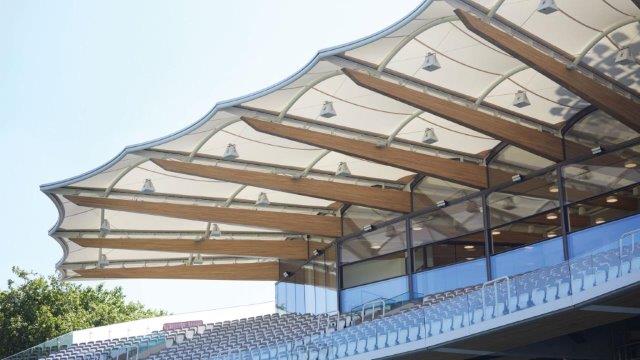
“An engineering marvel made of American white oak features in the redevelopment of the Warner Stand at one of the world’s most iconic sporting facilities, Lord’s Cricket Ground in St. John’s Wood, London. In this pioneering project, the roof of the stand is formed from 11 cantilevered, glue laminated (glulam) American white oak beams that radiate dramatically from the corner of the ground, paving the way for brave new structural uses of sustainable American hardwoods.“An engineering marvel made of American white oak features in the redevelopment of the Warner Stand at one of the world’s most iconic sporting facilities, Lord’s Cricket Ground in St. John’s Wood, London. In this pioneering project, the roof of the stand is formed from 11 cantilevered, glue laminated (glulam) American white oak beams that radiate dramatically from the corner of the ground, paving the way for brave new structural uses of sustainable American hardwoods.
American white oak is one of the most popular species from the U.S. hardwood forests, and is unique to North America. Its choice for the glulam beams was driven by its excellent strength properties relative to its weight, allowing the beams to be more slender than if they had been made from constructional softwood. It also increased their durability and offered a high-quality architectural finish.
- Each beam measures 900mm x 350mm at the deepest point. (2.95ft x 1.14ft)
- The longest glulam beam weighs approximately four (4) tons, and measures 23.4 meters (76.8ft) in length, the same as 26 cricket bats lined up nose to tail.
- They are all covered by a lightweight, fabric roof covering.
In total, 100m³or 42,387 board feet of Number 1 Common grade American white oak was used to create the 11 beams. Forest Inventory Analysis (FIA) data shows U.S. white oak makes up 15.7 percent of total forest cover, and that while 20.9 million m³ of American white oak are harvested each year, nearly 40 million m³ are growing in the hardwood forest in the same period.
Bottom line: It would take only 160 seconds for this material to be replaced through natural growth, across the vast American forests.” Visit www.americanhardwood.org to learn more.

